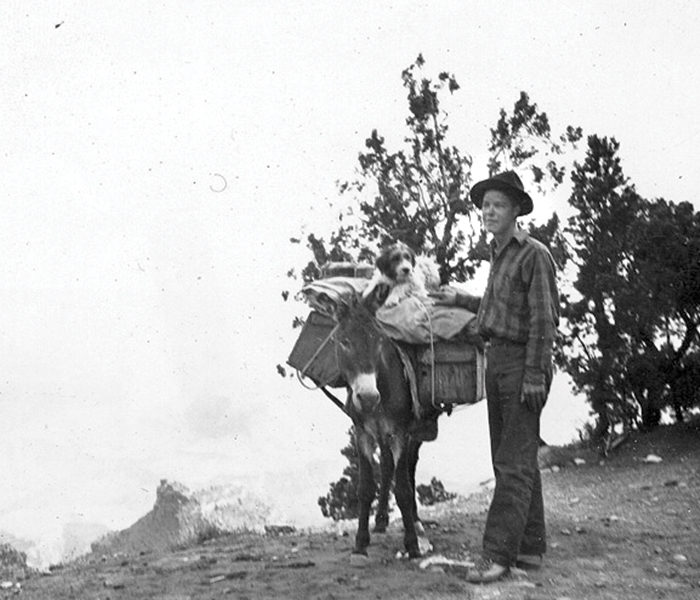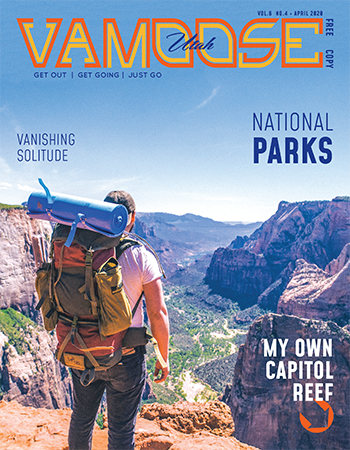The disappearance of Everett Ruess—Utah’s nomadic wanderer silent since 1934—tugs on our collective soul
By John Rasmuson
Like a Rorschach blot in shades of red ink, the Southern Utah landscape is subject to interpretation. Not everyone views it in the same way, but everyone sees opportunity there. Oilmen focus on its potential for profit. Landscape artist Maynard Dixon was drawn to its uncommon visuality. For Native Americans, the red rock represents a sacred ancestral home. Slick-rock trails draw mountain bikers and four-wheelers. Paleontologists imagine Jurassic reptiles. Edward Abbey described a “spiritual promise” so ineffable that perhaps only a few grokked it. “Ask Everett Ruess,” Abbey suggested in Desert Solitaire.
Unfortunately, Ruess didn’t live long enough to share whatever spiritual insight he had gained. He was just 20 years old when he disappeared. In 1934, he rode out of Escalante on a burro en route to Hole-in-the-Rock and was never heard from again. One of the books about him—Amazon offers 10—is A Vagabond of Beauty. The title is apt. Ruess devoted the better part of two years to vagabondage in the Southern Utah and Northern Arizona wilderness. His purpose, wrote Wallace Stegner a few years later, was the pursuit of beauty.
Some might object to Stegner’s phrase, “pursuit of beauty,” as being affected. But he was not romanticizing Ruess as a questing, Byronic figure. Rather, he was paraphrasing Ruess’s own words. In letters to his family, Ruess wrote explicitly and exuberantly about beauty: “I have seen almost more beauty than I can bear,” he wrote. “The country is fiercely, overpoweringly beautiful.”
That fiercely beautiful country encompassed Canyon de Chelley, Mesa Verde, Grand Canyon, Navajo Mountain and Zion National Park—and all points in between. Ruess was a traveler, not a tourist. He was exploring Monument Valley on foot years before John Ford made cowboy movies there, two decades before Abbey drove the unpaved roads of Arches National Monument as a government employee. As Ruess traversed the sere, red-rock landscape, he transcribed his experience into words, watercolor sketches and woodblock prints.
Once accommodated to Stegner’s “pursuit of beauty,” you have to make a judgment about Ruess’s credibility. Was he an esthete, wise beyond his years? Or a poser, juiced-up by adolescence? The answer is “yes” to both. His sincerity is never in doubt, but some of what he wrote is lyrical; some gives pause. The problematical passages include this one: “But he who has looked long on naked beauty may never return to the world, and though he should try, he will find its occupation empty and vain. … Alone and lost, he must die on the altar of beauty.”

Everett Ruess on the trail, with his dog, Curly
Ruess’ death was more likely an accident than a ritual sacrifice. His headlong pursuit of beauty may have led to a dark side, which Odysseus encountered on his way home from Troy. Hearing the seductively beautiful song of the Sirens, Odysseus evaded death because he was literally restrained. Ruess may have died because he was as incautious as Timothy “Grizzly Man” Treadwell, who was killed by a bear in 2003 after living among the grizzlies in Alaska’s Katmai National Park for 13 summers. Ruess was known to be reckless. “I have been flirting pretty heavily with death, the old clown,” he admitted in a letter. “In my wanderings this year I have taken more chances and had more wild adventures than ever before.” His last adventure played out in Davis Gulch, 50 miles south of Escalante, where search parties found his two burros in a makeshift corral, but no trace of him or his gear. Not even footprints.
Unresolved disappearances occupy a special place in the public consciousness. There is abiding interest in the fate of aviatrix Amelia Earhart, airplane hijacker D.B. Cooper, writer Ambrose Bierce and Malaysia Airlines Flight 370. Utah has its own mysteries—the Rhoades Mine, the Ancestral Puebloans, the men who left John Wesley Powell on the Colorado River in 1869 never to be seen again. Montezuma’s treasure? Who’s to say it isn’t cached in a cave near Bluff?
What became of the Ancestral Puebloans has scientific import. The Ruess disappearance has none. Nevertheless, he has a place of prominence in Utah legends. Walk into Ken Sanders’ bookstore, and you’ll find three books about Ruess next to the cash register. Chat up Sanders, a friend of Abbey, and he will tell you about a new Ruess documentary by French filmmaker Emmanuel Tellier. La Disparition d’Everett Ruess will be screened in Utah this summer, he will tell you.
What makes Ruess, a fresh-faced kid barely out of high school, such a compelling figure? Probably many reasons. Like an epistolary novel, the Ruess story spools out in letters and poems, embellished with sketches, photos and woodblock prints. It is the first-person narrative of a youthful adventurer, a self-styled artist, who walks the pristine wilderness with two burros, selling watercolor sketches along the way to buy food. By his own account, he lives in “dreamy intoxication from the serene beauty and perfect solitude.”
Ruess prefers the solitude of the desert to the cacophony of the city. “As to when I shall visit civilization, it will not be soon, I think,” he wrote to his brother in California from Escalante in November 1934. “I have not tired of the wilderness; rather, I enjoy its beauty and the vagrant life I lead, more keenly all the time.”
It may be that Ruess was reimagining his own life as a work of art—or art at work—but had not foreseen how it might finish. Perhaps he ventured beyond the point of no return on a haunted landscape. In 1776, Spanish explorers called the sheer-walled canyon country along the Colorado River Salsipuedes—meaning “get out if you can.” Either way, you can speculate over a campfire or write your own ending to the Ruess story as if you were back in sophomore English. Was he murdered? Drowned? Killed in a fall? Bitten by a rattlesnake?
Stegner gets an A-plus for his concluding paragraph: “Everett Ruess is immortal, as all romantic and adventurous dreams are immortal, He is, and will be for a long time, Artist in Residence in the San Juan country.”



